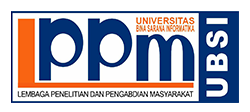Peran Media Massa Barat Membingkai Aksi Terorisme
Abstract
The 9/11 terrorism attack has become one of the issues covered specifically by the media. Terrorism stereotypes are closely related to Islam due to the prominence of news broadcast by the media. The media have a role in influencing public perceptions. Agenda setting and framing theory can explain that mass media has the ability to transfer two elements, namely awareness and information to the public agenda and its attention to issues that are only considered important by the mass media. The intensity of news about terrorism is broadcast more than in other spheres and the framing of terrorism is related to Islamic groups, thus affecting people's perceptions of labeling acts of terrorism that are identical to Islam. As well as using the functions of the media agenda, public agenda and policy agenda to analyze the role of the media in reviewing terrorism.
Keywords
Full Text:
PDFReferences
A. Muri Yusuf. (2014). Metode Penelitian Kuantitatif, Kualitatif & Penelitian Gabungan, Prenadamedia Group Jakarta.
Adegbola,O.,Skarda,J. & Gearhart,S. (2018). Everything’s negative about Nigeria: A study of US media reporting on Nigeria. Journal of Global Media and Communication.
Entman, R. (1993) Framing: towards clarification of a fractured paradigm. In Dudo, A. D. An Environmental Controversy: How Newspapers Framed Coverage of the Bush Administration’s Proposal to Drill for Oil and Natural Gas in the Arctic National Wildlife Refuge.
MA Dissertation, Faculty of the University of Delaware, United States of America.
Jaramillo, D. L. (2009). “Ugly War, Pretty Package: How CNN and Fox News Made the Invasion of Iraq High Concept”. Indiana: Indi- ana Univeristy Press.
Kerry,J.(2016).Remarks on community building and countering violent extremism. Washington, DC: US Department of State.
Laqueur, W. (2002). A History of Terrorism. New Jersey: Transaction Publishers.
Littlejohn, Stephen; Karen, A. Foss; and John G. Oetzel.(2017). Theories of Human Communication. Eleventh Edition. Belmont, CA: Thomson Wadsworth.
Maddox, T. (4 April 2003). “CNN and the war: Your questions”. CNN. Diakses pada 17 April 2020, dari https://edition.cnn.com/2003 /WORLD/meast/04/02/sprj.irq.cnn.qa/index.html.
Matusitz, J & Ochoa,D. (2018). Agenda-Setting Theory in the U.S. Media: A Comparative Analysis of Terrorist Attacks in France and Nigeria. Global Media Journal. Nicholaon School of Communication and Media, University of Central Florida, Sanford, USA.
McCombs M (2014) Setting the Agenda: The Mass Media and Public Opinion, 2nd edn. Cambridge: Polity Press.
McQuail, D &Windahl, S.(1981) Communication Models for the Study of Mass Communications. London: Longman.
Miller, K. (2000) Communication Theories: Perspective, Processes and Context. Boston: McGraw Hill.
Nurdin, dkk,. (2016). Media dan Politik. CV. Riau Pekanbaru: Kreatif Multimedia.
Nurudin. (2017). Pengantar Komunikasi Massa. Cetakan-8. Jakarta: RajaGrafindo Persada.
Pickering, M. (2001), Stereotyping: The Politics of Representation, Houndmills, Basingstoke, Hampshire & New York: Palgrave.
Rena,N.,Putri,P.& Resen,P. (2020). Konstruksi Opini Publik Sekuritisasi Terorisme 9/11 Pemerintah Amerika Serikat Melalui Media Massa. Fakultas Ilmu Sosial dan Ilmu Politik Universitas Udayana.
Republika. (2020). “Riset: Media Inggris Lebih Sering Labelkan Islam Teroris”. Diperoleh melalui situs:https://republika.co.id/berita/qfode3320/riset-media-inggris-lebih-sering-labelkan-islam-teroris (diakses pada 13 Januari 2021)
Severin, W.J. & Tankard, J. W (2001) Communication Theories: Origin, Methods, and Uses in the Mass Media (5th edition). New York: Longman.
Sitorus, A & Sutoyo, J. (2014). Konstruksi Kompas Tentang Terorisme: Analisis Framing Pemberitaan Peledakan Bom Bali I. Departemen Kriminologi, Fakultas Ilmu Sosial dan Ilmu Politik, Universitas Indonesia.
Yusof, S. dkk. (2013). The Framing of International Media on Islam and Terrorism. European Scientific Journal : University of Putra, Malaysia.
DOI: https://doi.org/10.31294/jkom.v13i2.11756
| Index by: | ||








|
||
| E-ISSN: 2579-3292 | ||

 https://road.issn.org/sites/all/themes/customroad/img/road-issn.png
https://road.issn.org/sites/all/themes/customroad/img/road-issn.png
|
||
Dipublikasikan oleh LPPM Universitas Bina Sarana InformatikaJl. Kramat Raya No.98, Kwitang, Kec. Senen, Kota Jakarta Pusat, DKI Jakarta 10450
|








